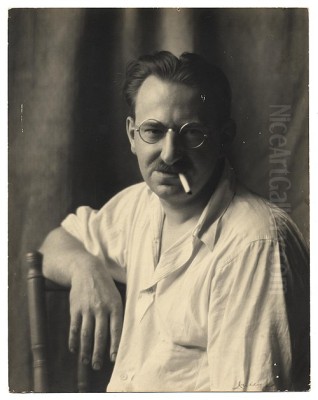
Emil Ganso stands as a significant, albeit sometimes overlooked, figure in early twentieth-century American art. Born in Germany and later immigrating to the United States, Ganso navigated a path from humble beginnings as a baker to becoming a respected painter, printmaker, and educator. His work, characterized by technical proficiency and a warm, observant realism, captured the landscapes, cityscapes, and intimate figure studies of his time. He mastered multiple media, leaving behind a substantial body of work in oil painting, wood engraving, etching, and lithography, securing his place within the narrative of American modernism.
From Halberstadt to New York: An Unconventional Path
Emil Ganso's life began in Halberstadt, Germany, in 1895. His heritage was a blend of German, French, and Spanish roots, perhaps hinting at the diverse influences that would later shape his artistic perspective. Seeking opportunity, the young Ganso emigrated to the United States in 1912. Like many immigrants, his initial years were marked by practical labor; he found work as a baker's apprentice and later as a dishwasher, moving between cities to make a living. Art, however, was a persistent calling.
Despite the demands of manual labor, Ganso pursued art through self-study. His formal training commenced in 1914 at the prestigious National Academy of Design in New York City, though his time there was relatively brief. The year 1915 marked an early milestone when he exhibited work at the Erhard Weyhe Gallery, a venue known for its support of printmakers and modern artists. A period of financial hardship followed in 1916 when he lost his baking job, leading him to embrace what was described as a "Bohemian life," surviving on minimal income while dedicating himself more fully to his artistic pursuits. By 1921, Ganso began exhibiting his work as an independent artist, signaling his definitive transition from tradesman to professional artist.
Mastery Across Media: The Printmaker's Art
While Ganso was proficient in oil painting, his reputation was significantly built upon his exceptional skill as a printmaker. He explored various techniques with remarkable facility, producing over fifty woodcuts, more than one hundred etchings, and a similar number of lithographs throughout his career. His technical command was widely acknowledged, particularly in the demanding medium of wood engraving.
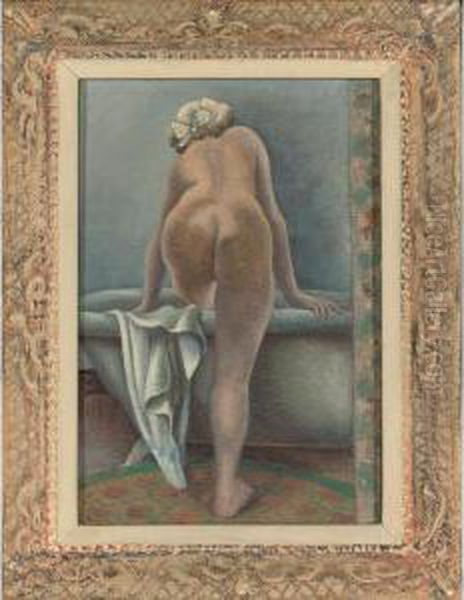
Ganso became known for his use of hard Turkish boxwood for his engravings. This dense wood allowed for incredibly fine lines and intricate details, enabling the creation of complex textures and tonal variations. Furthermore, the durability of the boxwood blocks permitted larger print editions than softer woods would allow, making his work more accessible. His prints often possess a distinct warmth and painterly quality, demonstrating that technical precision did not preclude expressive depth in his work.
A standout example of his printmaking is the wood engraving At the Seashore (1932). This work showcases his ability to render light, form, and texture through meticulous line work, capturing a moment of leisure with sensitivity and skill. It exemplifies the blend of realism and subtle stylization that characterizes much of his graphic output. His prints covered a range of subjects, from intimate nudes and portraits to evocative landscapes and city views.
Painting, Themes, and Sensibilities
Emil Ganso's paintings complemented his graphic work, often exploring similar themes with a different textural and chromatic richness. His subject matter frequently included the female nude, a recurring motif treated with varying degrees of innocence and sensuality. Works like The Bathers demonstrate his interest in the human form within natural settings, rendered with a characteristic solidity and warmth.
Landscapes and cityscapes also featured prominently in his oeuvre. Whether depicting the tranquility of the countryside, as seen perhaps in works like The River, or the specific character of urban environments, Ganso approached these subjects with a keen observational eye. His oil painting Snow Scene (1941), created in the last year of his life, likely captured the atmospheric effects of light and weather with the same careful attention found in his prints. Still lifes provided another avenue for exploring form, texture, and composition.
Ganso's predominant style is best categorized as Realism, grounded in careful observation and representation of the visible world. His work often possesses a tangible quality, a sense of volume and presence. While one source mentions inspiration from Abstract Expressionism, this seems incongruous with the bulk of his work and timeline; his art aligns more closely with the American Scene Painting and realist traditions prevalent during his active years, albeit infused with his unique technical finesse and European-informed sensibilities.
European Experiences and Connections
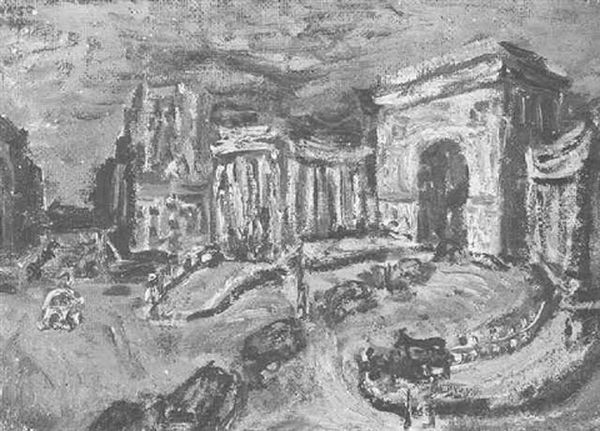
Like many American artists of his generation, Ganso sought experience and inspiration in Europe. In 1925, he traveled to Paris, the undisputed center of the art world at the time. This period proved fruitful for networking; he connected with fellow artists such as Georges Acktman, Catherine Goodman, and Doris Kelley. His time abroad also brought recognition, including a medal from the French Photographic Society, indicating his engagement with the broader visual culture of the era.
A significant mark of distinction came in 1932 when Ganso was awarded a prestigious Guggenheim Fellowship. The fellowship was granted specifically for the study of graphic arts processes abroad, allowing him to deepen his technical knowledge and immerse himself further in European art currents. This opportunity undoubtedly enriched his practice and solidified his reputation upon his return to the United States. His work gained further visibility through inclusion in major exhibitions, including the New York World's Fair and the Golden Gate Exposition.
Artistic Circles and Contemporary Context
Emil Ganso operated within a dynamic American art scene. His association with the Weyhe Gallery from 1925 provided crucial financial stability and connected him to a circle interested in printmaking and modern art. Later, he also exhibited at the Downtown Gallery, another important venue promoting contemporary American artists. A 1930 exhibition there, titled "Americans Abroad," featured Ganso alongside artists like Jules Pascin, "Pop" Hart, Stuart Davis, Stefan Hirsch, and Robert Laurent.
Jules Pascin, a Bulgarian-born artist known for his sensitive, often erotic, depictions of women, became one of Ganso's closest friends in America. This friendship highlights Ganso's connection to a more bohemian, internationally-flavored circle within the New York art world. His name also appeared on promotional materials for the Downtown Gallery alongside Stuart Davis, a key figure in American modernism known for his proto-Pop abstractions. Ganso was also associated with artists like Fletcher Martin and Leon Kroll, prominent realists of the period.
To fully appreciate Ganso's position, it's helpful to consider him alongside other major figures active during his time. His realist inclinations and focus on American subjects resonate with the work of Edward Hopper, though Ganso's style was often warmer and less stark. Like Reginald Marsh, he depicted scenes of contemporary life, though often with less emphasis on urban bustle. His commitment to printmaking parallels that of Rockwell Kent, another master of graphic media known for dramatic landscapes. He shared gallery space (Downtown Gallery) and certain modernist sensibilities with Yasuo Kuniyoshi. While distinct from the earlier Ashcan School artists like John Sloan and George Bellows, Ganso built upon the tradition of depicting everyday American life they helped establish.
Educator and Final Years
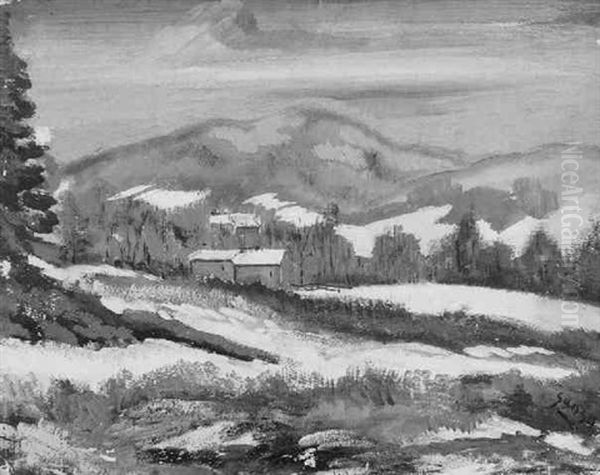
In his later career, Emil Ganso's contributions extended into art education. He served as an artist-in-residence at Lawrence College in Appleton, Wisconsin, sharing his expertise with students there. This was followed by a more formal academic appointment in 1938 as a professor at Iowa State University. This position reflected his established reputation and provided a platform to influence a new generation of artists in the Midwest.
His time as an educator marked a period of significant professional recognition. Tragically, his tenure was cut short. Emil Ganso died suddenly of a heart attack in Iowa in 1941, at the relatively young age of 46. His death occurred just as he was reportedly about to be granted a permanent professorship, a testament to the value placed on his teaching and artistic practice by the university community.
Legacy and Collections
Although his career was prematurely ended, Emil Ganso left a significant artistic legacy. His work continued to be recognized posthumously. A major retrospective exhibition was held at the Brooklyn Museum in 1944, three years after his death, offering a comprehensive overview of his achievements in both painting and printmaking. This exhibition helped solidify his place in the annals of American art history.
Today, Emil Ganso's works are held in the permanent collections of numerous major American museums, affirming their enduring quality and importance. These institutions include the Metropolitan Museum of Art, the Whitney Museum of American Art, and the Brooklyn Museum in New York City. His prints and paintings can also be found at the Art Institute of Chicago, the Detroit Institute of Arts (which holds his painting The River), the Cleveland Museum of Art (where the Cleveland Print Club donated his wood engraving At the Seashore), and the Victoria and Albert Museum in London, among others. The presence of his work in these esteemed collections ensures its availability for future study and appreciation.
Conclusion: An Enduring Realist Voice
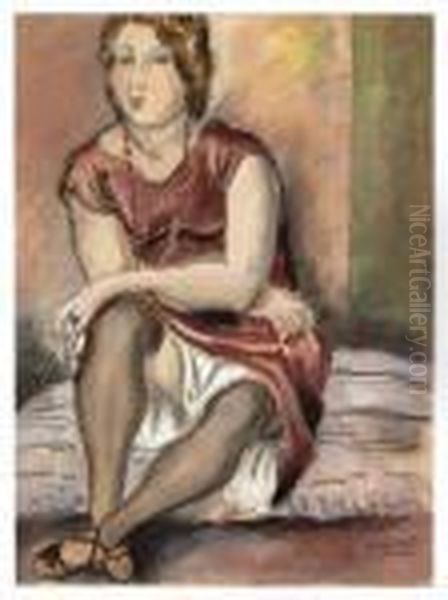
Emil Ganso's journey from a German immigrant baker to a respected American artist and educator is a compelling story of dedication and talent. He distinguished himself through exceptional technical skill, particularly in the demanding media of printmaking, while maintaining a warm, humanistic focus in his depictions of people, places, and objects. His art provides a valuable window into the American scene of the 1920s and 1930s, rendered with a blend of realist observation and subtle European sophistication. Though perhaps not as widely known today as some of his contemporaries, Emil Ganso's substantial body of work, preserved in major museum collections, confirms his status as a significant and accomplished artist within the broad spectrum of twentieth-century American realism.